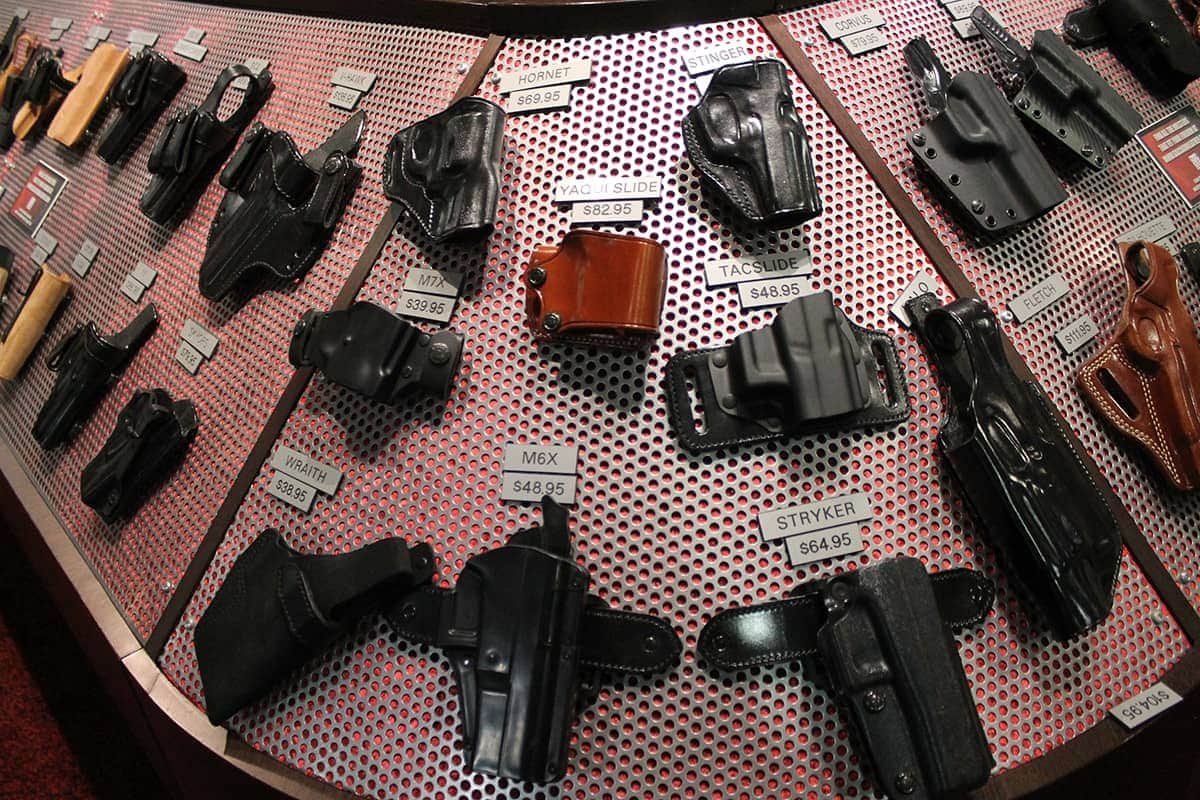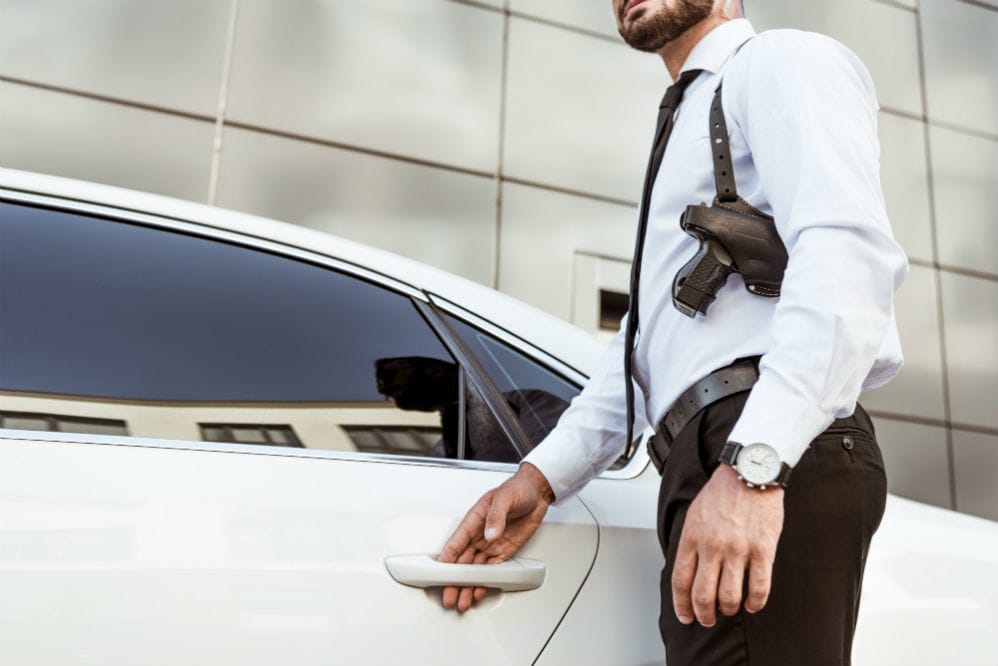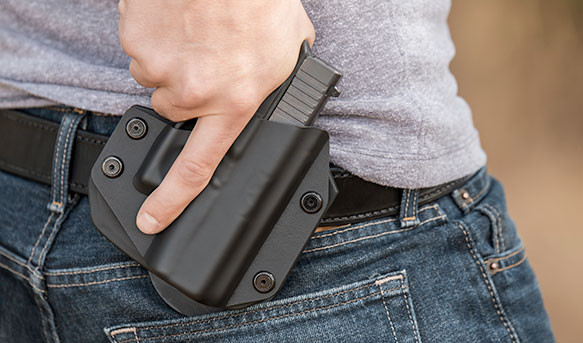
Holsters 101:
A Complete Guide
Starting off as a well-decorated leather or fabric scabbard to the latest complex and simplistic designs, holsters have come a long way in development. The design of the holster and the way you carry it can mean the difference between success or failure in an important situation.
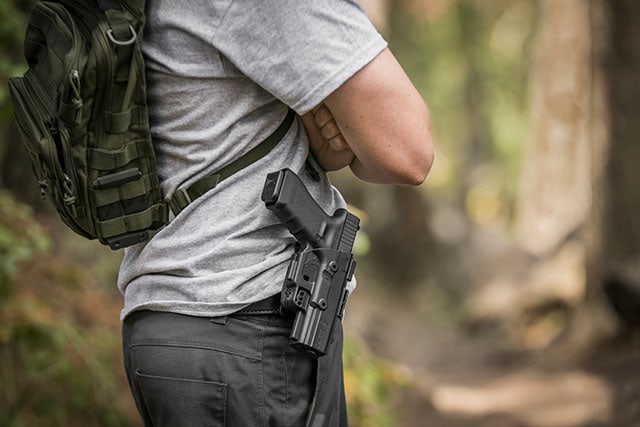
Photo credit: AlienGearHolsters.com
This comprehensive guide is intended to shed more light on such factors and enlighten you on everything related to choosing a holster. Take a look at the index below to get a quick overview:
Holster Basics
A holster is a kind of case used to hold a handgun securely while being carried by the user. A holster serves three purposes: safety of the firearm, quick handling, access/draw when needed and concealment (if applicable).
Types of Holsters & Carry Styles
There are two broad terminologies that can be used to define the type of a holster: design and carry style. Both determine the effectiveness of a draw in different situations: they all have their pros and cons.
There are three types of holsters when we look at them through the angle of intended application:
Duty/Tactical Holsters: These holsters are characterised to be used by Law Enforcement Officers and military operatives and are designed to offer easy, quick and unhindered access to the handgun. While also keeping it secure enough to ensure that it doesn’t fall out under strenuous movement or by a hostile during melee engagements.
Concealment Holsters: As the name suggests, these holsters are used to conceal the firearm while carrying. Such holsters are designed to not outline their profile and remain inconspicuous while movement. The kind of clothing you wear also affects their efficacy.
Sporting Holsters: These holsters are used for competitions or at the range. Their basic purpose is to offer a quick draw and re-holstering, which is the essence of many competitive sports involving handguns.
Furthermore, holsters can be broken down based on their design or carry style, which also implies where and how they should be worn.
IWB Holsters: IWB stands for Inside the Waistband. These holsters are tucked between the lower garment (jeans, trouser, skirt, etc) and your body. Hence offering great concealment.
OWB Holsters: Outside the Waistband holsters are generally used for openly carrying the firearm with quick access and limited concealment. These can be carried using a gun belt or a paddle attachment.
Belly Band Holsters: This is a wide fabric holster with a band that is wrapped around your belly. This doesn’t require any belt or paddle and is strictly IWB. These holsters offer a lot of extra space for additional items.
Shoulder Holsters: These holsters are worn around the torso and often worn inside a jacket or a coat. These can have an extra magazine pouch attachment for balance and ammo backup. Mostly preferred by undercover law enforcement agents.
Pocket Holsters: A simple nylon or leather case that is used to conceal and carry small handguns inside the pocket of your trousers or a ladies purse.
Ankle Holsters: This holster is worn on the ankle and often used for concealed backup handguns.
Thigh Holsters: As the name suggests, these are worn across the right or left thigh for quick access. These are mostly used by the infantry personnel for quick access to their sidearm. There are also ‘garter holsters’ similar to these and specially designed for women.
Chest Holster Rigs: These are popular among trekkers and campers who want to carry their firearm along with other gear and still have easy access. The handgun stays positioned right in the centre of your chest.
Uncommon Designs: Some manufacturers have started to experiment with unconventional designs like clip holsters that replace the rear slide cover on a semi-auto pistol and attach a clip there. Many other unique designs fall into this category including: minimalistic trigger guard holsters, fanny pack holsters, purse holsters, carry bags, and custom clothing like tactical jackets and pants.
Holster Carry Positions
Let’s take a look at different carry positions and how they affect handling/drawing, specific to holsters that sit on the hips (most common).
The carry position of a holster is denoted by the position of the hour hand on a clock. Consider yourself standing on the center pivot of a clock with dead-ahead being the 12 O’Clock mark. Now each hour mark across this clock will denote your carry position.
- The 12 O’Clock carry position is one of the most unhidering positions to conceal and carry a firearm. It’s generally going to be most comfortable while sitting or driving. An IWB or groin holster can be used to carry a handgun here. Many men are cautious about this style though, for obvious reasons.
- The 1 O’Clock position, commonly known as the appendix carry is the most common carry position for IWB and also OWB.
- The 3 O’Clock (or 9 O’Clock) position also known as the strong side hip carry (depending upon what’s your dominant hand) is mostly used for OWB holsters and is great for range use, self defense and competitions.
- The 4 and 5 O’Clock positions (also sometimes known as kidney carry) are also a bit prevalent with OWB holsters. Especially if the user doesn’t have to do a lot of sitting.
- The 6 O’ Clock position, more popularly known as the SOB or Small of Back is a very commonly used carry position. With specially designed holsters (known as SOB holsters) to offer comfortable carry over your spine. This position is great for concealment and comfort while sitting. It can be used for IWB and OWB holsters.
Holster Reviews By Type & Carry Style
Holster Materials
A holster's prime characteristic is to hold the firearm securely while also protecting its finish and being comfortable, too. The level of comfort depends upon the many variables, materials being possibly the most contributory:
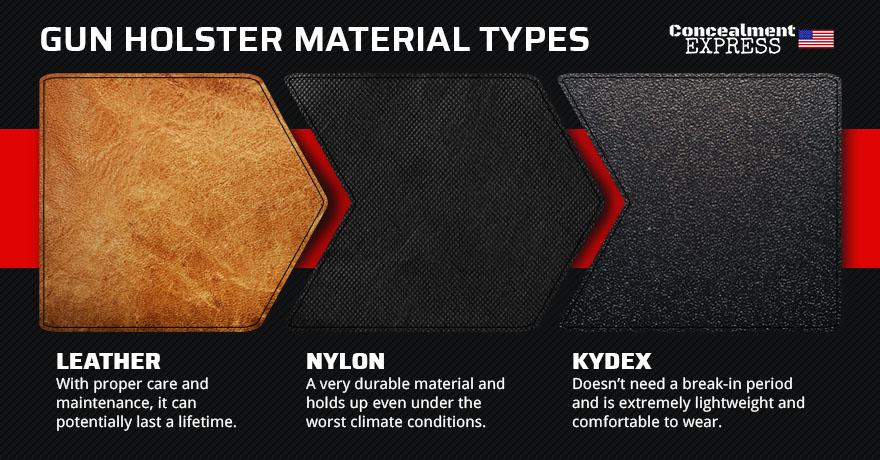
Photo Credit: concealmentexpress.com
Leather Holsters
Early on, holsters were all designed using leather. Today they’re still very common and relatively durable. Leather holsters are generally more expensive than most other holster materials, depending on the grade of leather and the level of craftsmanship involved.
But leather holsters are long lasting if cared for. You’ll need to do some oiling and maintenance of the holster. Keep in mind most leather items take some time to break-in, too. But after this period, a leather holster is one of the most comfy and classic pieces of gear you’ll have.
Another advantage of a leather holster is that the soft inner lining doesn’t scratch or mar the finish of the weapon when drawing or reholstering. The durability and protective benefits make them great for collector’s guns.
Leather holsters generally rely upon passive retention (the firmness of the material) or have a strap mechanism to be more secure.
Thermoplastics: Kydex, Boltaron, & More
The most common material used these days for designing holsters is thermoplastics. With the most popular of them being Kydex and Boltaron holsters. These thermoplastics are lightweight and cheap to manufacture. Plus, they retain their shape and allow for single-handed, easy and quick re-holstering.

Such holsters are resistant to corrosion, solvents and can be easily washed and maintained with no serious effort. However, the drawbacks are generally that they aren’t very protective for the firearm’s finish and also don’t offer a silent draw.
You can read more here about Leather vs Thermoplastic Holsters
Nylon & Other Synthetic Fabrics
Nylon is a soft fabric that is mostly used to make universal holsters. Since combining it with other elastic materials or simple safety straps to obtain a good fit is quite easy.
Nylon holsters are very protective on the firearm’s finish and are also comfortable for the user due to their soft nature.
Picking The Right Holster: Questions to Ask Yourself
Choosing the right holster can be overwhelming with so many carry styles, holster materials, etc. We’ve highlighted the major questions you should ask yourself along with some discussion as to why:
Proper Holster Fitment
Getting comfortable with carrying your firearm begins with understanding how to properly position the holster, and understanding the implications of each holster type.
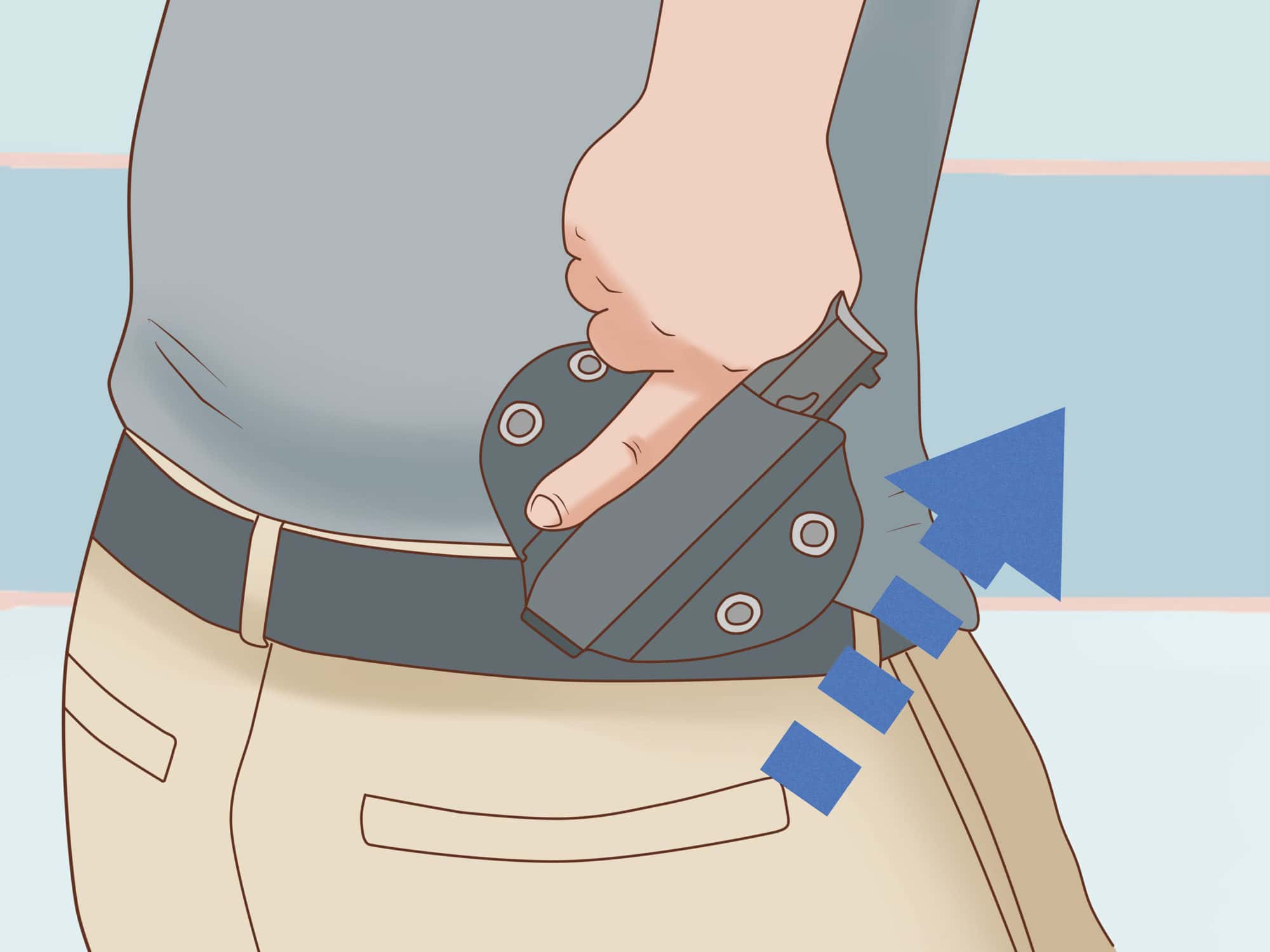
Photo Credit: WikiHow.com
We've generated many guides on how to wear different types of holsters, which you can explore here:
Where Will You Carry Your Firearm?
If you need a holster, it obviously means that your handgun will be carried places. Now the question of ‘where to’ will be a big factor in deciding what holster you should choose. Let’s take a look at the possible scenarios:
To The Range
Choosing a holster for range use has its own inherent considerations. First of all, at the range, you are generally not in a hurry to draw or holster your firearm.
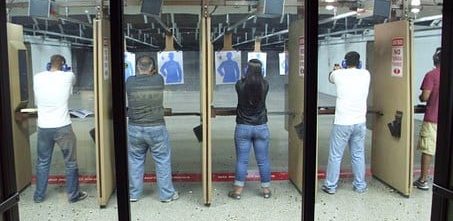
You may be practising your accuracy, speed of acquisition or any other skill you need to acquire. Ranges are great for practice. Plus, they do not require you to conceal the firearm. So unless you are practicing drawing with a concealed carry holster. An OWB holster that allows you to quickly and easily draw your handgun will be best.
Also, there’s no one planning to snatch your weapon or attack you on a range. So overly complex retention mechanisms aren’t important either. But then, it could depend on what you are practicing!
Open-Carry or Concealed Carry
Some states allow their residents to openly carry firearms. Whereas others require them to concealed carry a weapon (CCW) with a valid license.
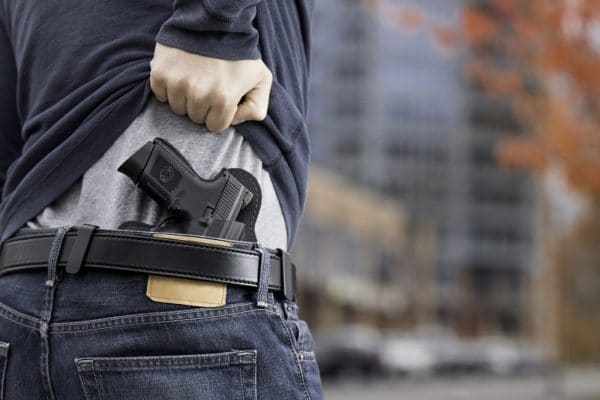
Photo Credit: AlienGearHolsters.com
As far as open carry is concerned, an OWB, thigh or shoulder holster (without a jacket) are potential options. Just make sure your holster offers a good retention mechanism and doesn’t protrude too much and snag on everything.
For CCW uses, IWB holsters, belly bands, ankle holsters, pocket holsters and other designs which offer good concealment are best. If you are considering CCW, we highly recommend taking good concealed carry course, and be aware of your local and federal self defense laws.
While Running or During Workouts
Some people prefer absolutely no compromise with safety and carry a handgun as a part of their body. You may want to carry your handgun while strolling out for a walk, jogging or even when hitting the gym (we’ve seen it!).
Belly band holsters and ankle holsters work best for this scenario. They are mostly made of nylon and can withstand the movement. They’re also flexible which generally keeps them comfortable. Additionally, belly band holsters may offer multiple pockets to carry other stuff like your phone, headphones, etc.
At Your Workplace
When carrying a firearm at your workplace, it has to be absolutely inconspicuous so it doesn’t offend anyone and also to abide with CCW laws.
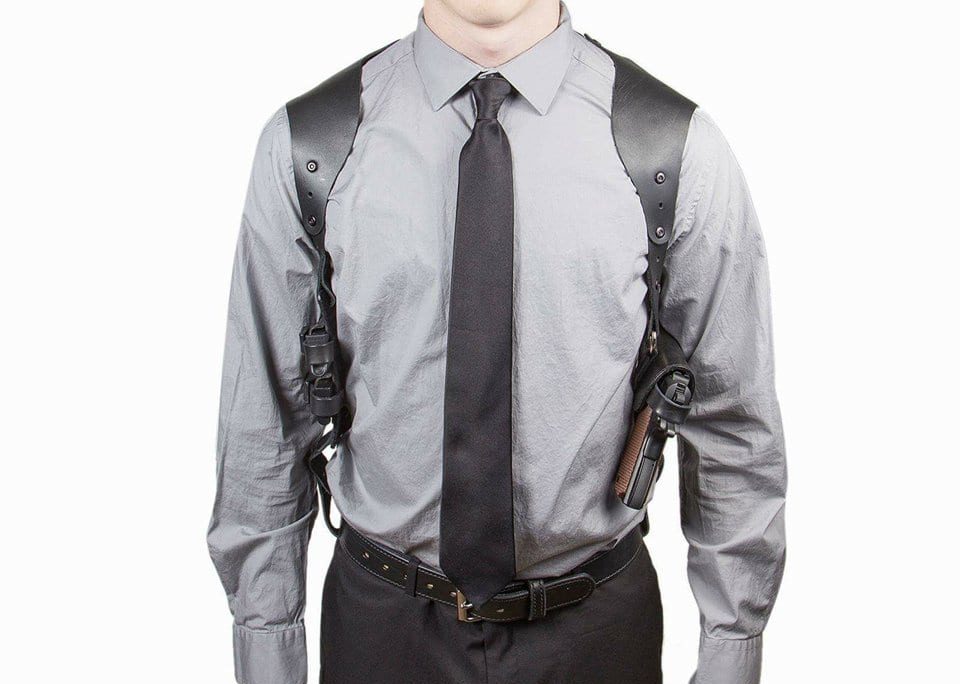
The choice of your holster also depends on whether you have a sedentary job, or one that requires physical activity.
Inside Your Car
Driving around in your car is a regular daily activity for most people. If you drive a lot with your holster on, you want something that doesn’t dig into your pelvis. SOB and appendix carry IWB holsters are great for this.
Alternatively, many companies offer dedicated car holsters that allow you to securely and secretly store a weapon inside your car or truck with quick access. However, make sure you are aware of the laws for carrying a gun in vehicles.
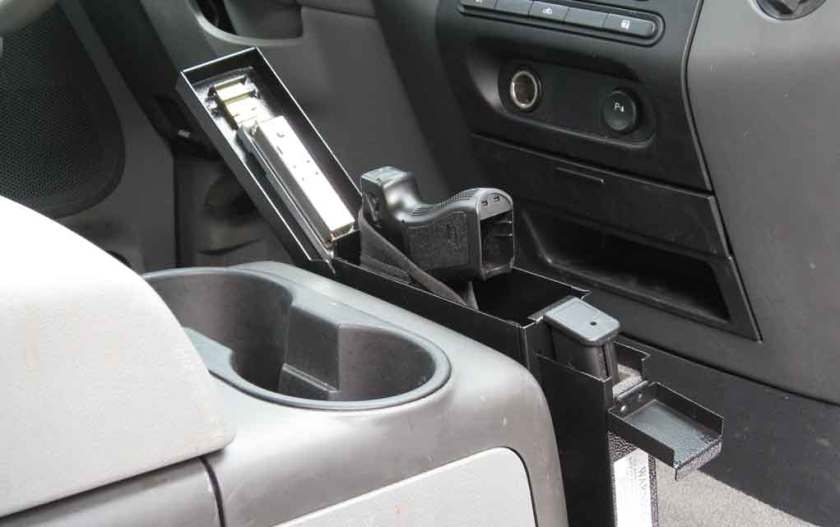
Active Duty Officers
LEO’s generally opt for OWB holsters that offer quick access and have good retention. While on active duty, a holster must be quickly reachable and secure enough so nobody other than the bearer can draw the weapon.
Shoulder holsters are a great option for undercover agents. Also, an ankle holster is great for carrying a backup weapon. On duty officers don’t have to hide their weapons, so concealment is generally not of concern.
Competitions
Competitions require quick holsters that feature a simple retention mechanism. Particularly nothing too complex that might cost you precious time when drawing the weapon. Thermoplastic holsters or specialty/dedicated designs work best in this case.
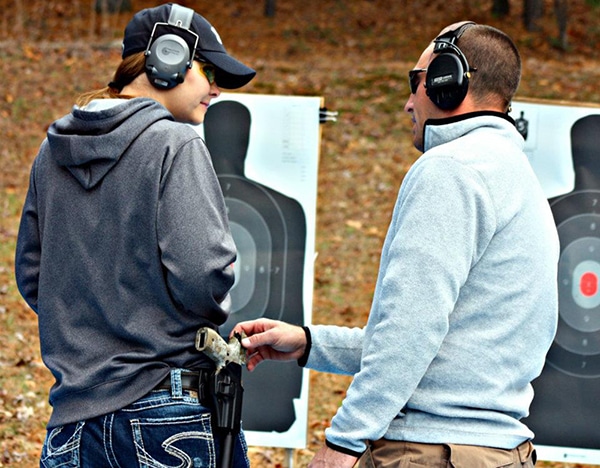
Photo Credit: Carolinasfirstdefense.com
Most competitions also have rules, and holsters may need 'approval' to be used in the competition, such as IDPA Holsters.
How Often and How Long Will You Wear It?
A holster is like an extra garment, like an overcoat or scarf. You may wear it all day if necessary, but you still prefer to take it off when you get a chance. Let’s understand some considerations related to how long you’ll wear the holster.
Only While Moving
Say you are a law enforcement officer with a desk job. Or a workshop manager who sits in his/her cabin peacefully most of the day. Typically you’ll only want to wear a holster while you’re driving to and from your workplace or walking around. So your holster and your body will experience minimal contact.
When wearing a holster for such short durations, factors like sweating (which can also damage the finish of the firearm or the holster) and mild discomfort aren’t as crucial. You’ll just need a holster that holds your firearm securely and doesn’t cost too much.
Occasionally or A Few Hours at a Time
Some people may prefer carrying their handguns only on certain occasions. Like when visiting a party, a public place (where firearms are allowed), weekend trips, camping or any other occasional event.
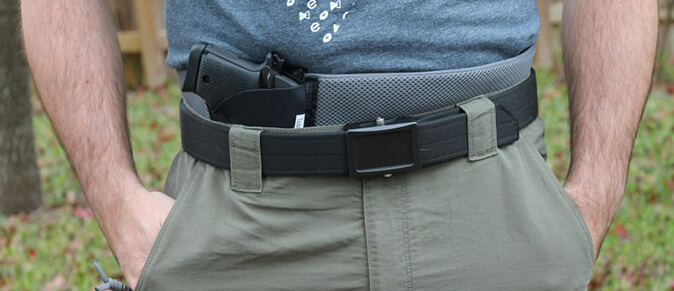
Photo Credit: Thetruthaboutguns.com
If you are one among them, a holster compatible with your carry preference (open or concealed) and a focus on comfort will be best.
All Day
If you are wearing your holster for the entire day (or at least 8 hours at a time), it’s likely safety is a real and constant concern for you. This can be the case if you are an active duty LEO, or just very cautious.
The factor of comfort is important here, especially if you want to carry concealed. Sweating will be a major concern, especially during the summer or for those living in the South.
It’s better to choose an IWB holster with a breathable and soft backing, along with a full length sweat guard to restrict contact between your handgun and your body. If concealment is not your problem, a good OWB or shoulder holster will do the trick.
Planning on Using Accessories or Modding Your Firearm?
The term accessories here refers to two things: modifications and upgrades for the weapon, or the desire to carry extra items with your holsters (like a spare mag).
Many firearm enthusiasts modify their weapons, either motivated by aesthetics, applications, or efficiency. Some common customizations to the handguns that concern holsters include flashlights, lasers, suppressor sights, barrel swaps, and slides.
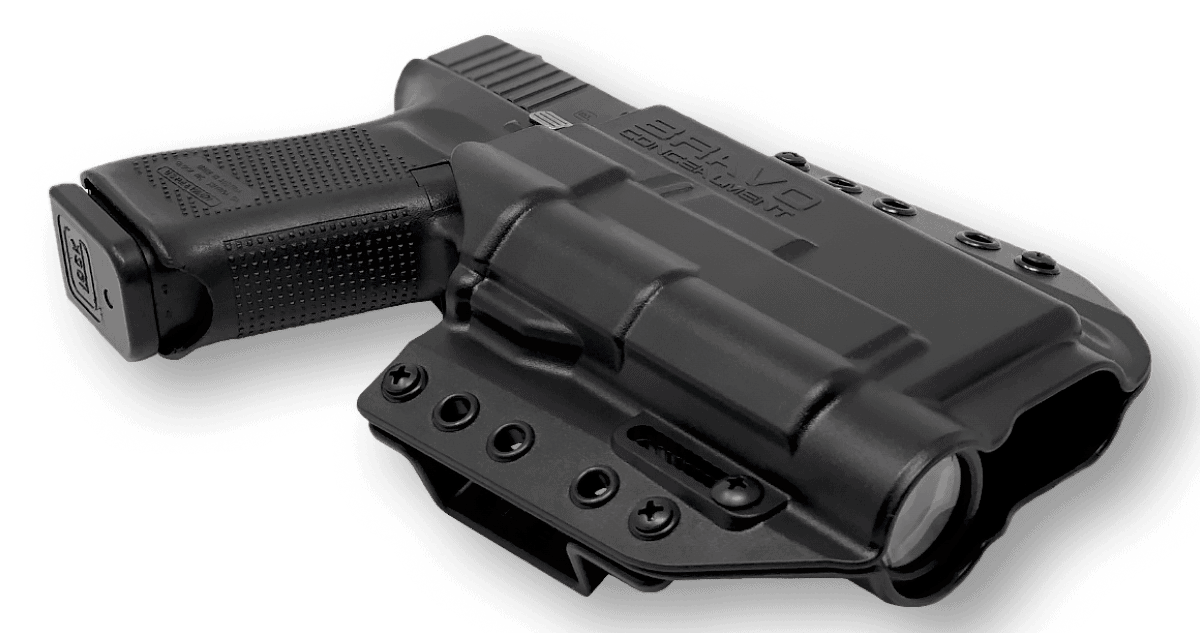
Photo Credit: BravoConcealment.com
The most common aftermarket accessory mounted on handguns are night sights. However, some users prefer adding silencers to their handgun which requires a higher pair of sights. Accommodating such sights in a holster requires higher channel clearance - so keep an eye out for that.
The next most common are lights and lasers. While there are innovative options that fit inside the handgun frame or sit quietly on the grip. Flashlights or lasers are typically mounted under the barrel and require a dedicated holster with proper clearance.
As far as barrel length is concerned, holsters with open bottom design eliminate this problem since they allow the barrel to pass through the base. However, these designs are considered less safe (by some, it's debateable).
Next, some people like to carry extra mags, a knife, flashlight, cellphone or any other extra accessory with their handgun. Some holsters offer space for extra mags, whereas others offer a modular design (like in some shoulder holsters) to mount other accessories.
Belly band holsters are the most versatile in this case. Since they generally offer multiple pockets and a universal fit.
What Clothing Will You Typically Wear?
The clothing you don while carrying a holster also plays an important part in deciding your choice of holster. Luckily, there’s a wide range of concealed carry clothing available on the market for better options.
Let's talk about clothing considerations for various scenarios:
Cold Climates
Winter clothing is exceptionally great for concealment of holsters. While thick sweaters, sweatshirts and hoodies eliminate the possibility of printing when wearing an IWB holster. Garments like overcoats, jackets and suits can ensure that even OWB holsters stay concealed.

One important factor to consider is that the thick layers of clothing can hinder easy access to the holster. It is important to ensure that you can still easily reach and access your firearm in an emergency situation. Belly bands are the one standout option that’s not a good pick because of this.
Shoulder holsters, pocket holsters (especially inside a jacket) and even ankle holsters work well for winter clothing. There is a wide variety of tactical vests and concealed carry jackets for men and women that can be used to effectively CCW with your holster.
Hot Climates
Light clothes are slightly difficult to work with when concealing a holster. But there are options out there that can minimize printing.
Hot weather generally calls for holsters able to handle conditions that cause perspiration. As mentioned earlier, a full length sweat guard and a breathable backing definitely helps.
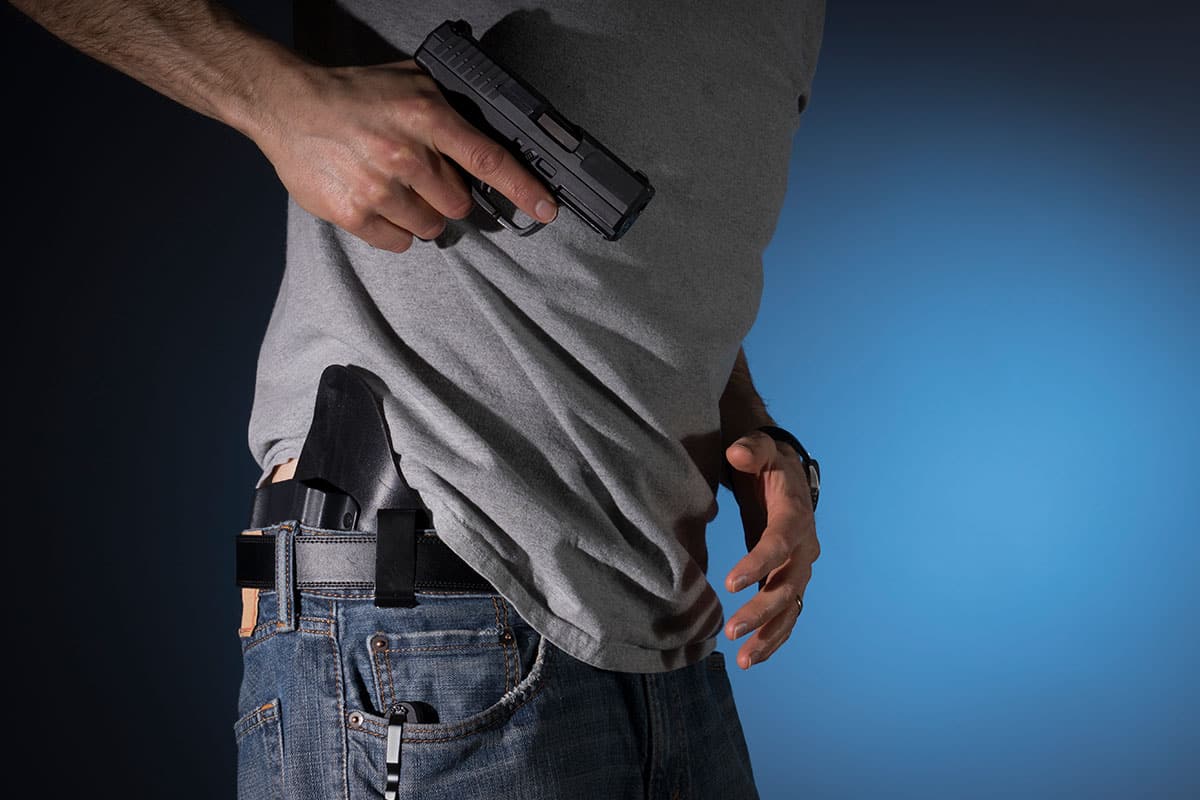
Photo Credit: highcaliber.corsizio.com
OWB holsters eliminate the problem of perspiration. But they absolutely compromise on concealment because there is no extra clothing like jackets to hide the holster. Sticky pocket holsters with a rounded shape that minimizes printing can be an option for summer use. Additionally, ankle holsters work great with baggy or regular fit trousers.
Thigh rigs are also a great option if concealment is not your concern.
Belts: Often Necessary
Donning a belt gives you a stable foundation that not only keeps your jeans in place, but is also sturdy enough to let you draw the firearm without bringing the holster along with it.

Photo Credit: nfscinc.com
Overall, wearing a dedicated gun belt is always good practice. Additionally, there are tactical trousers available on the market that can help with carrying a holster. Otherwise, some paddle holsters can eliminate the need to use a belt.
Wearing Shorts
This directly concerns thigh and ankle holsters. While a thigh holster can be exposed or concealed, carrying an ankle holster that remains exposed is not a good idea. Since it is close to the ground, your firearm will collect dirt and possibly snag other objects. Plus, you’ll just plain look silly.
For Our Heavier Readers
Unique struggles inflict those who have larger frames. Perspiring, holsters digging into your sides, holster printing, and difficulty finding gun belts to name a few.
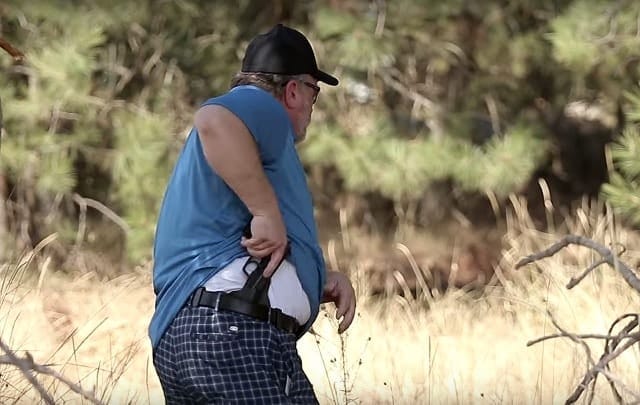
These folks are generally best suited to using belly band holsters or off-body carry styles. Read more about your options in our article on Holsters for Heavier Individuals!
What About Considerations for the Ladies?
While most holsters are generic solutions with often unisex designs. Ladies have to face some unique and often peculiar issues while carrying handguns due to some of their clothing choices and body structure.
But there are some very effective, dedicated solutions to combat this:
Belly Bands - The Most Common Solution
Nothing beats a belly band holster when worn with the right clothing. The band can be adjusted according to waist size, often has a breathable neoprene backing and offers a unifit holster with a lot of extra storage space.
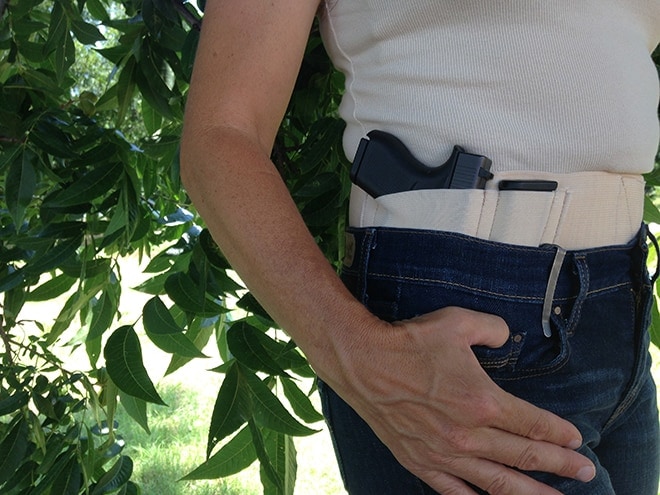
Photo Credit: thewellarmedwoman.com
A belly band with the right fit for your waist will be a stable and suitable option even when performing strenuous physical activities.
Obviously, they offer very little concealment when worn with crop-tops or other skin-tight upper garments.
Off-Body Holster Options
!
This is one of the most effective and relatively common options of carrying handguns for women. Almost every woman carries a handbag, big or small. There are dedicated designs of concealed carry purses, fanny-packs, and other bags available on the market. These can be used with pocket holsters or specially designed purse holsters to carry handguns.
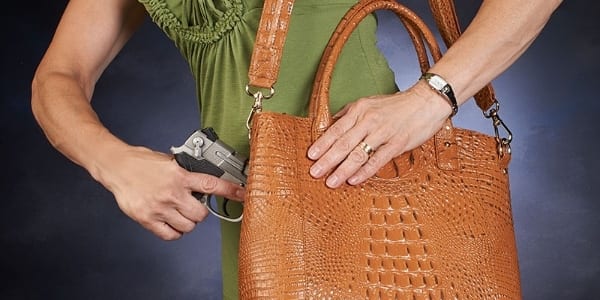
With some training and practice, it can be a viable carry option that offers concealment and keeps the handgun secure and away from your body.
Options for Skirts & Dresses
Wearing a dress long or short doesn’t mean you cannot carry. The best option when wearing such garments is a thigh holster that can be supported by a garter belt.
If you plan on wearing a jacket or a coat, a shoulder holster may also be a good option. Or, if your clothing combination is a skirt with an untucked top, a belly band holster or slim profile IWB holster can also work great.
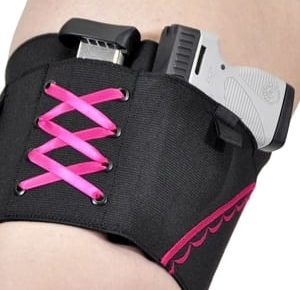
Bra & Corset Holsters
These options are suitable for ladies wearing a t-shirt or top. The idea behind bra holsters is to utilize the already elastic innerwear to firmly hold the holster in place, while also allowing quick full-grip access in need. Bra holsters are similar to chest holsters - they just stay inverted and concealed.
Corset holsters are another suitable alternative to belly band holsters. These are worn around the waist and work like a high positioned IWB holster. These are very adjustable and offer a universal fit.
Other Dedicated Garments
Tank tops, shirts, shorts and leggings with built-in elastic holsters and fatale holsters to be worn around the ankle. Many companies offer such dedicated clothing solutions to carry handguns around.
We cover these and many more in our review of the Best Holsters for Women!
Popular Holster Brands
Let’s get to know the market. There are a ton of companies that manufacture a boatload of holsters in a variety of designs. But there are some companies that dominate the market due to their quality, designs and customer service.
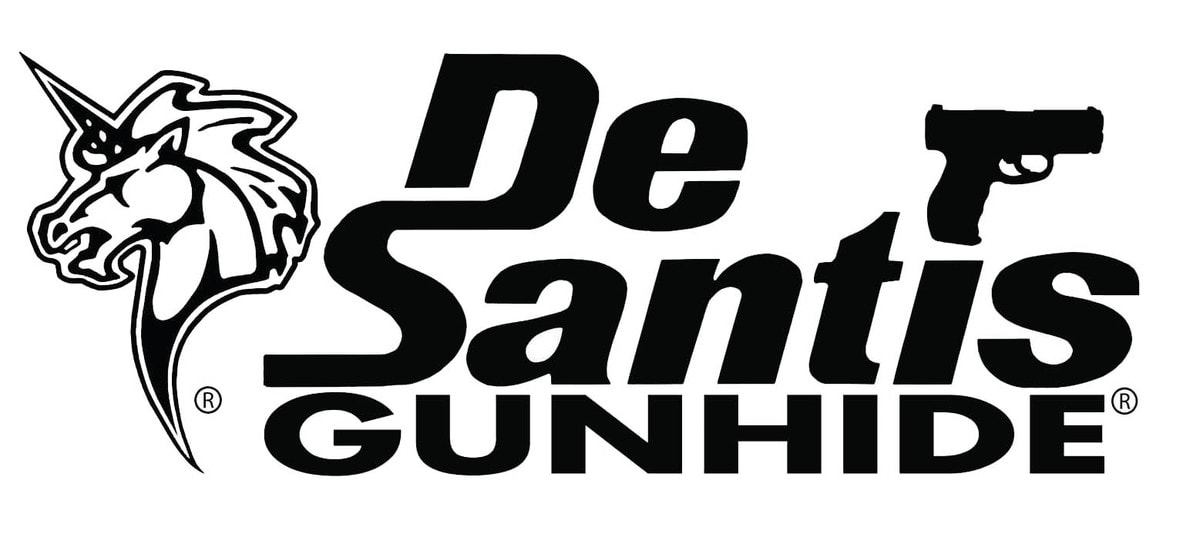

Top Holster Brands
Some of these holster brands are only limited to the U.S market. Whereas others have a worldwide presence in the civilian and military market. This list is based upon positive user feedback, track record, and versatility of inventory.
Safariland: Safariland offers a wide variety of options and is used by most LEO departments in the country and the US Military. The Safariland 7TS ALS series is used by FBI and US Military. The company has been around since 1964 and is based in Jacksonville, FL.
Alien Gear: This company gained its reputation after introducing its shapeshift and Cloaktuck™ line of holsters. Which is a modular holster setup that allows the user to quickly change configuration. It specializes in CCW holsters for personal defense and is based in Idaho.
DeSantis Gunhide: A family owned company founded 50 years ago by Gene DeSantis. The US based company supplies holsters to many law enforcement agencies around the globe. They are known for their handmade leather holsters and quality craftsmanship
Concealment Express: A US based company that sources all its raw materials from within the country. The company gained traction after its IWB concealment holster became insanely popular among CCW and EDC users. All their holsters are covered by an unconditional lifetime warranty.
ComfortTac: This company is the king of brands when it comes to belly band holsters. Theirs are the most popular and widely selling across the nation. ComfortTac is owned by Joe Cochran and is based in Knightdale, NC. Their amazing fit and quality has made them number one in a very short duration.
Galco Gunleather: Galco is known for their high quality leather holsters. Especially shoulder holsters and belts. The company was founded by Richard N. Gallagher in 1969 and is currently based in Phoenix, Arizona.
CYA Supply Co: A relative new-comer, but CYA earns a spot on this list because they sell some of the most economical and high quality thermoplastic holsters. Especially IWB models designed for M&P Shield and Glock 43 handguns. It is a veteran owned and operated business.
Blackhawk: The company is credited with developing the SERPA auto lock technology that made the holster’s retention very secure. Their holsters were and also are used by many LE departments. The company has an astoundingly versatile inventory ranging from hydration systems to protective gloves.
Fobus: Fobus is a renowned and leading Israeli company that manufactures holsters, mag pouches and other accessories. They introduced injection molded polymer holsters in the market and currently carry over 160 different holster designs in their inventory.
Relentless Tactical: Again, an American company known for their high quality leather belts and holsters and a lifetime warranty cover. Their focus is towards making products from US leather right here in the country.
Uncle Mike’s: Any American gun owner will know this name. The company has been around since 1947 and carries a large inventory of holsters and related gear. Their holsters are inexpensive and rugged - the workhorse of holsters.
UTG: UTG is a brand name owned by Leapers Inc. A US based company and known for their high quality nylon holsters. Especially thigh rigs and adjustable unifit holsters. They offer almost every holster design at an inexpensive price. They also offer a lifetime warranty for craftsmanship and material defects.
We maintain a running list of active Holster Manufacturers if you are interested in seeing other possible options!
Model Specific vs. Universal Holsters
While most users prefer model specific holsters, universal holsters have also proven themselves as viable alternatives. Let’s investigate these holster types in more detail.
When Are Universal Holsters A Good Idea?
Universal holsters have a mixed fanbase. Some consider them really useful whereas others cite about their stability and fit issues. Here are a few situations when universal holsters can be a good idea:
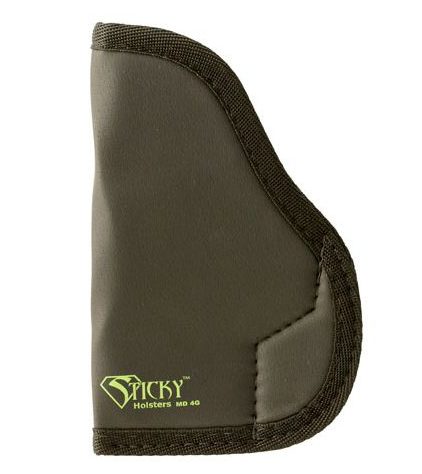
Universal Pocket Holster. Photo Credit: StickyHolsters.com
Useful for Storage
Unifit holsters are mostly made from nylon and can be very cheap to procure in bulk. So these holsters can be a great tool to organize your gun safe (and it’s door organizer) with all your handguns stacked properly and protected.
Switching Firearms Often
Perhaps an unusual scenario, but there can be times when you have to switch among handguns. Maybe at the range or just swapping your handgun with your friend for a while. A universal holster can make quick handgun swaps easy, no matter what the frame size.
When No Dedicated Holsters Are Available
Sometimes you may get stuck in a situation where the fit of any holster does not suit your weapon (perhaps due to modifications). A universal holster can help resolve this problem by being adjustable or elastic, offering the snug fit other holsters could not.
When Firearm-Specific Holsters Are Best
Most users prefer to use a holster that has been modelled specifically for their firearm. Which indeed is a better option in most cases.
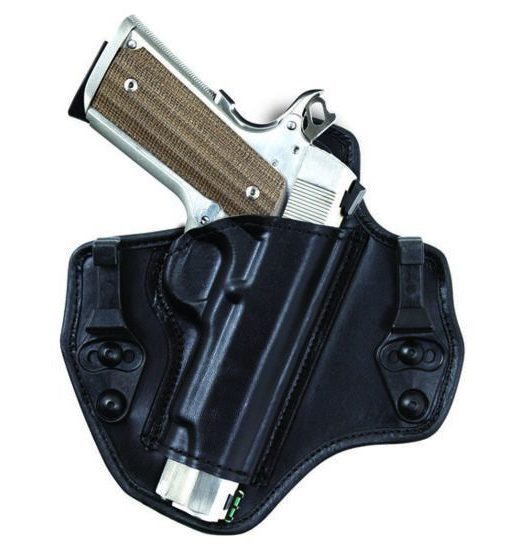
Photo Credit: Safariland.com
A firearm-specific holster works best in cases where a holster relies upon passive retention. Meaning that the snug fit of the holster is what keeps the firearm inside and in place. The shape of the holster is designed to replicate that of the handgun. Matching all the curves and grooves for the perfect fit.
Such a holster also ensures that its design conforms to the dimensions of your handgun. Hence you can expect a proper full-grip access when you need your weapon. Problems like an exposed trigger guard and uneven shape that promotes printing are addressed by firearm-specific holsters.
This is an important consideration when choosing a holster for CCW also. Firearm-specific holsters are tested to ensure good fit and proper concealment with the specific firearm. A properly tested and evaluated holster instills confidence in the bearer that the holster will really do what it claims.

Such holsters are essential when chances are high you’ll end up involved in serious situations. This involves active duty officers and defense personnel. Getting involved in a SHTF moment may require frequent and mistake-free drawing and holstering of the weapon. A proper fit holster (especially with a solid non-snagging opening) is crucial.
Firearm-specific holsters are also useful for competitions. Where the margin of error is minimal and one has to perform rigorous physical movements and necessitates repetitive use of the holster.
Check out all our firearm specific reviews here!
Firearm Specific Holster Reviews
Conclusion
A holster is an essential gear if you are carrying your handgun around. It keeps your weapon secure, ensures your safety and offers you a stable platform to quickly access the weapon when needed.
There’s a wide range of holsters out there designed for specific applications, situations and firearms. It all depends on how you resonate with the considerations within this article.
Thanks for stopping by!

HVAC Training 101 is a participant in the Amazon Services LLC Associates Program, an affiliate advertising program designed to provide a means for us to earn fees by linking to Amazon.com and affiliated sites. Pages on this site may include affiliate links to Amazon and its affiliate sites on which the owner of this website will make a referral commission
